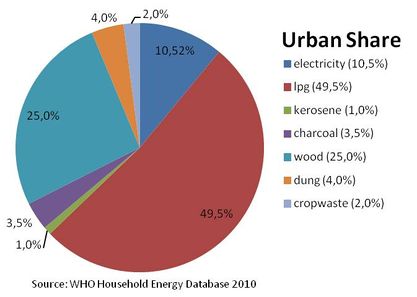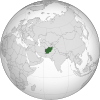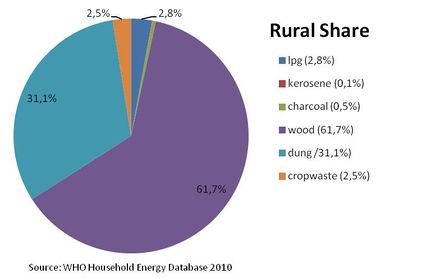Difference between revisions of "Afghanistan Energy Situation"
***** (***** | *****) |
***** (***** | *****) |
||
| Line 1: | Line 1: | ||
| − | = | + | = = |
{| style="float: right" cellspacing="0" cellpadding="0" width="400" border="1" | {| style="float: right" cellspacing="0" cellpadding="0" width="400" border="1" | ||
| Line 202: | Line 202: | ||
Electrification rate in households:<ref>The National Risk and Vulnerability Assessment 2005, Kabul, Afghanistan. Cited in WHO (2009) The Energy Access Situation in developing Countries</ref><br>National: 23%, urban: 74%, rural: 3%<br> | Electrification rate in households:<ref>The National Risk and Vulnerability Assessment 2005, Kabul, Afghanistan. Cited in WHO (2009) The Energy Access Situation in developing Countries</ref><br>National: 23%, urban: 74%, rural: 3%<br> | ||
| − | = | + | = Policy framework, laws and regulations = |
| − | = | + | = Relevant Institutions and organisations = |
| − | |||
| − | |||
| − | |||
| − | |||
| − | |||
| − | |||
| − | |||
| − | |||
| − | |||
| − | |||
| − | |||
| − | |||
| − | |||
| − | |||
| − | |||
| − | |||
| − | |||
| − | |||
| − | |||
| − | |||
| − | |||
| − | |||
| − | |||
| − | | ||
| − | |||
| − | |||
| − | |||
| − | | ||
| − | |||
| − | |||
| − | |||
| − | |||
| − | |||
| − | |||
| − | |||
| − | |||
| − | |||
| − | |||
| − | |||
| − | |||
| − | |||
| − | |||
| − | |||
| − | |||
| − | |||
| − | |||
| − | |||
| − | |||
| − | |||
| − | |||
| − | |||
| − | |||
| − | |||
| − | |||
| − | |||
| − | |||
| − | |||
| − | |||
| − | |||
| − | |||
| − | |||
| − | |||
= Existing projects = | = Existing projects = | ||
| − | |||
| − | |||
| − | |||
| − | |||
| − | |||
| − | |||
| − | |||
| − | |||
<br> | <br> | ||
Revision as of 10:48, 14 December 2011
| Afghanistan | |||
| |
| ||
|
Capital |
Kabul (34° 32′ 0″ N, 69° 10′ 0″ E) | ||
|
Official language(s) |
Dari (Persian) and Pashto | ||
|
Government |
Islamic republic | ||
|
President |
Hamid Karzai | ||
|
Prime Minister |
| ||
|
Total area |
647,500 km2 | ||
|
Population [1] |
29.8 million | ||
|
Rural-Population |
23 million (77%) | ||
|
Urban-Population |
6.8 million (23%) | ||
|
Population Density |
43 Persons per km² | ||
|
Average Household Size |
11.4 | ||
|
GDP (nominal) |
$15.608 billion | ||
|
GDP per Capita |
$517 | ||
|
Currency |
Afghani (AFN) | ||
|
Time Zone |
CET (UTC+04:30) | ||
|
Calling Code |
+93 | ||
Environmental Situation
Climate
Arid to semiarid; cold winters and hot summers
Mean temperature (°C min/max): 4.3/19.6 [2]
Resources
Natural gas, petroleum, coal [1]
Forest Situation
Land area covered by forest: 1.3%
Forest annual rate of change: 0% [3]
Socioeconomical Situation
Income Sources
Agriculture: 79%, industry: 6%, services: 16%
Energy Situation
Type your text here
Energy Supply
Electricity
Sources
Hydropower 63,7% and fossil fuels 35,3%
Stability
Type your text here
Energy Consumption
Type your text here
National Level
Electricity
Household Level
Percentage of energy types used for cooking in rural areas [4]

Percentage of energy types used for cooking in rural areas. [4]
Percentage of Population Using Solid Fuels
National: >95% [5]
Solid Fuel Use Impact on Health
Total annual deaths attributable to solid fuel use: 23900 persons
Percentage of national burden of diseases attributable to solid fuel use: 4.9% [6]
Access Rate
Electrification Rate
Electrification rate in households:[7]
National: 23%, urban: 74%, rural: 3%
Policy framework, laws and regulations
Relevant Institutions and organisations
Existing projects
References
- ↑ 1.0 1.1 CIA - The World Factbook: https://www.cia.gov/library/publications/the-world-factbook/geos/af.html
- ↑ UN Data (2008): http://data.un.org/CountryProfile.aspx?crName=Afghanistan
- ↑ FAO (2011) The State of the World's Forest
- ↑ 4.0 4.1 WHO 2010: WHO Household Energy Database
- ↑ WHO (2006): Fuels for Life
- ↑ WHO (2006): Fuels for Life
- ↑ The National Risk and Vulnerability Assessment 2005, Kabul, Afghanistan. Cited in WHO (2009) The Energy Access Situation in developing Countries























